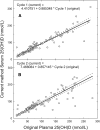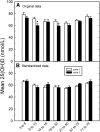Standardizing 25-hydroxyvitamin D values from the Canadian Health Measures Survey
- PMID: 26423385
- PMCID: PMC4625585
- DOI: 10.3945/ajcn.114.103689
Standardizing 25-hydroxyvitamin D values from the Canadian Health Measures Survey
Abstract
Background: The Canadian Health Measures Survey (CHMS) is an ongoing cross-sectional national survey that includes a measure of 25-hydroxyvitamin D [25(OH)D] by immunoassay. For cycles 1 and 2, the collection period occurred approximately every 2 y, with a new sample of ∼5600 individuals.
Objective: The goal was to standardize the original 25(OH)D CHMS values in cycles 1 and 2 to the internationally recognized reference measurement procedures (RMPs) developed by the US National Institute for Standards and Technology (NIST) and Ghent University, Belgium.
Design: Standardization was accomplished by using a 2-step procedure. First, serum samples corresponding to the original plasma samples were remeasured by using the currently available immunoassay method. Second, 50 serum samples with known 25(OH)D values assigned by the NIST and Ghent reference method laboratories were measured by using the currently available immunoassay method. The mathematical models for each step-i.e., 1) YCurrent = XOriginal and 2) YNIST-Ghent = XCurrent -were estimated by using Deming regression, and the 2 models were solved to obtain a single equation for converting the "original" values to NIST-Ghent RMP values.
Results: After standardization (cycles 1 and 2 combined), the percentage of Canadians with 25(OH)D values <40 nmol/L increased from 16.4% (original) to 19.4% (standardized), and values <50 nmol/L increased from 29.0% (original) to 36.8% (standardized). The 25(OH)D standardized distributions (cycles 1 and 2 analyzed separately) were similar across age and sex groups; slightly higher values were associated with cycle 2 in the young and old. This finding contrasts with the original data, which indicated that cycle 2 values were lower for all age groups.
Conclusion: The shifts in 25(OH)D distribution brought about by standardization indicate its importance in drawing correct conclusions about potential population deficiencies and insufficiencies and in permitting the comparison of distributions between national surveys.
Keywords: CHMS; adequacy; immunoassay; population survey; standardization; vitamin D.
© 2015 American Society for Nutrition.
Figures




References
-
- Whiting SJ, Langlois KA, Vatanparast H, Greene-Finestone LS. The vitamin D status of Canadians relative to the 2011 Dietary Reference Intakes: an examination in children and adults with and without supplement use. Am J Clin Nutr 2011;94:128–35. - PubMed
-
- Janz T, Pearson C. Vitamin D blood levels of Canadians. Ottawa (Canada): Statistics Canada; 2013.
-
- Hollis BW. The determination of circulating 25-hydroxyvitamin D: no easy task. J Clin Endocrinol Metab 2004;89:3149–51. - PubMed
-
- Hollis BW. Circulating 25-hydroxyvitamin D levels indicative of vitamin D sufficiency: implications for establishing a new effective dietary intake recommendation for vitamin D. J Nutr 2005;135:317–22. - PubMed
Publication types
MeSH terms
Substances
LinkOut - more resources
Full Text Sources
Other Literature Sources
Medical

